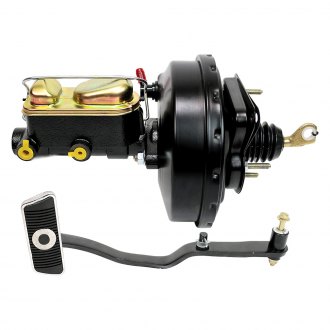If you have the room to change your pedal ratio (giving your foot more leverage) without the pedal bottoming out against something, increase it, and you will substantially improve your line pressure. Alternatively, you can go to a ¾" master cylinder.
One of the challenges you want to be sensitive to, if you choose the ¾" master cylinder solution, is the potential to run out of master cylinder volume if you have big brakes with big pistons. This situation produces a problem known as no brakes ...
The ⅞" master is usually a good choice in most applications. You need to get your pedal leverage up to snuff, so it is not necessary to bust your gut to stop the car. Proper brake pedal mechanical advantage (leverage) will allow you to easily execute a stop w/o an extraordinary amount of pedal pressure.
If you have room in your chassis, and if you have sufficient vacuum at idle, you might want to try one of the old-style vacuum brake boosters, like the one below from a 1970 mustang:

Alternatively, you could use one of Ford's HydroBoost systems. However, they will require a power steering pump to operate. This is what a HydroBoost adapter for a '79 - 93 Fox Body mustang looks like from the side:

Same Hydroboost from the front:

As you can see from the comparison to the ⅜" fasteners this unit uses, it is vanishingly small compared to the older style vacuum-assisted model. The pictured unit uses an aluminum adapter to change the master cylinder bolt pattern from a 12 o'clock / 6 o'clock positioning to a 9 o'clock / 3 o'clock positioning. It does, however, require the use of a power steering pump. That said, a low manifold vacuum at idle has no impact on its performance.
Four different solutions to your dilemma. One is correcting your mechanical pedal advantage, one selects a different master cylinder, and two use different booster assists to achieve essentially the same end. One of the four will fit your needs better than the other three. Only you know which one it is.
I hope this helps.